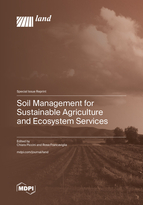Soil Management for Sustainable Agriculture and Ecosystem Services
A special issue of Land (ISSN 2073-445X). This special issue belongs to the section "Soil-Sediment-Water Systems".
Deadline for manuscript submissions: closed (15 July 2022) | Viewed by 36448
Special Issue Editors
Interests: geostatistics; digital soil mapping; soil science; sustainable agriculture; soil and water conservation
Special Issues, Collections and Topics in MDPI journals
Interests: soil organic carbon content; soil fertility; soil biodiversity; land-use/land-cover change; SOC simulation models
Special Issues, Collections and Topics in MDPI journals
Special Issue Information
Dear Colleagues,
We are pleased to invite you to contribute with your papers to the Special Issue “Soil Management for Sustainable Agriculture and Ecosystem Services” in Land.
Soil ecosystem services include the direct and indirect benefits that people obtain from soils. These include (1) provisioning services, such as food, feed, fibre, and fresh water; (2) regulating services, such as flood and disease control, and climate regulation; (3) supporting services, such as soil formation, water and nutrient cycling, the production of atmospheric oxygen, and provisioning of habitats.
Utilising soil for agriculture inevitably leads to changes in soil properties such as nutrient status, pH, organic matter content, and physical characteristics. In many cases, changes that are beneficial for food production are detrimental to other ecosystem services. Core farming practices such as soil tillage, crop residue management, nutrient management, and pest management impact a range of soil functions and ecosystem services, including water availability for crops, weed control, insect and pathogen control, soil quality and functioning, soil erosion control, soil organic carbon pool, environmental pollution control, greenhouse gas emissions, and crop yield productivity.
Since prevailing farming paradigms point to the conflict between high crop yields and low environmental impact, it is of crucial importance to define an environmentally sound range of agronomic activities that would be considered tolerable at a certain extent of intensity. Sustainable agriculture mainly focuses on increasing the productivity of the soil and reducing the harmful effects of agricultural practices on climate, soil, water, environment, and human health. Aspects such as an increase in soil fertility, protection of water, and protection of biodiversity need to be taken into account.
Following the principles of sustainable agriculture, soils must be protected and developed, water and water resources must be protected, natural control of pests and diseases should be adopted, and different agricultural products should be cultivated. Managing soil organic carbon is central because soil organic matter influences numerous soil properties relevant to ecosystem functioning and crop growth.
In this Special Issue, original research articles and reviews are welcome. Research areas may include, but are not limited to, the following:
- Minimising soil erosion from agricultural land;
- Maintaining and improving soil productivity;
- Managing soil nutrients;
- Maintaining and improving soil organic matter;
- Optimising soil physical conditions for crop growth—bulk density, water infiltration, etc.;
- Water management and conservation;
- Understanding and optimising soil biological processes;
- Cover crops and rotations/diversity;
- No till/conservation tillage;
- Root–soil interactions;
- Pests and diseases management;
- Possible beneficial impacts of biochar on soil properties and crop growth.
We look forward to receiving your contributions.
Dr. Dr. Chiara Piccini
Dr. Rosa Francaviglia
Guest Editors
Manuscript Submission Information
Manuscripts should be submitted online at www.mdpi.com by registering and logging in to this website. Once you are registered, click here to go to the submission form. Manuscripts can be submitted until the deadline. All submissions that pass pre-check are peer-reviewed. Accepted papers will be published continuously in the journal (as soon as accepted) and will be listed together on the special issue website. Research articles, review articles as well as short communications are invited. For planned papers, a title and short abstract (about 100 words) can be sent to the Editorial Office for announcement on this website.
Submitted manuscripts should not have been published previously, nor be under consideration for publication elsewhere (except conference proceedings papers). All manuscripts are thoroughly refereed through a single-blind peer-review process. A guide for authors and other relevant information for submission of manuscripts is available on the Instructions for Authors page. Land is an international peer-reviewed open access monthly journal published by MDPI.
Please visit the Instructions for Authors page before submitting a manuscript. The Article Processing Charge (APC) for publication in this open access journal is 2600 CHF (Swiss Francs). Submitted papers should be well formatted and use good English. Authors may use MDPI's English editing service prior to publication or during author revisions.
Keywords
- sustainable agriculture
- soil ecosystem services
- soil erosion
- soil productivity
- soil nutrients
- soil organic matter
- soil physics
- soil biological processes
- water management
Related Special Issues
- Soil Management for Soil Health in Land (7 articles)
- Soil Management for Sustainability in Land (17 articles)







